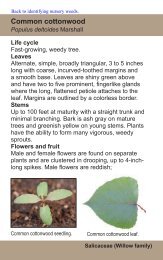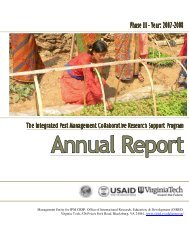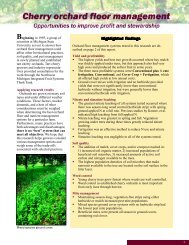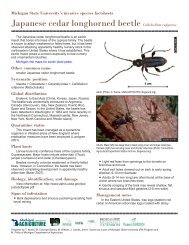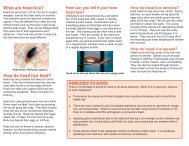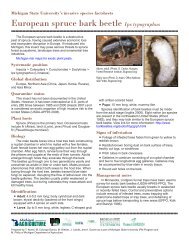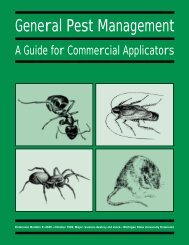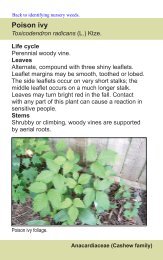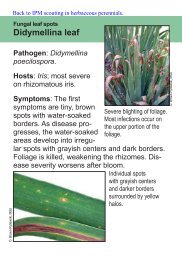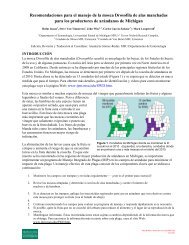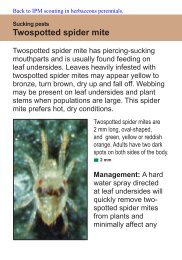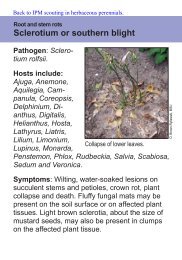Whole Manual - Michigan State University: Integrated Pest ...
Whole Manual - Michigan State University: Integrated Pest ...
Whole Manual - Michigan State University: Integrated Pest ...
Create successful ePaper yourself
Turn your PDF publications into a flip-book with our unique Google optimized e-Paper software.
BIOMAGNIFICATION—The process whereby one<br />
organism accumulates chemical residues in higher concentrations<br />
from organisms it consumes.<br />
BOTANICAL PESTICIDE—A pesticide produced from<br />
chemicals found in plants. Examples are nicotine,<br />
pyrethrins, and strychnine.<br />
BRAND NAME—The name or designation of a specific<br />
pesticide product or device made by a manufacturer or<br />
formulator; a marketing name.<br />
BROADCAST APPLICATION—A uniform pesticide<br />
application to a field or site.<br />
CALIBRATE, CALIBRATION OF EQUIPMENT, OR<br />
APPLICATION METHOD—The measurement of dispersal<br />
or output and adjustments made to control the rate<br />
of dispersal of pesticides.<br />
CARBAMATES (N-methyl carbamates)—A group of<br />
pesticides containing nitrogen, formulated as insecticides,<br />
fungicides and herbicides. The N-methyl carbamates<br />
are insecticides and inhibit cholinesterase in<br />
animals.<br />
CARCINOGENIC—The ability of a substance or agent<br />
to induce malignant tumors (cancer).<br />
CARRIER—An inert liquid, solid, or gas added to an<br />
active ingredient to make a pesticide dispense effectively.<br />
A carrier is also the material, usually water or oil, used to<br />
dilute the formulated product for application.<br />
CARRYOVER (HERBICIDE)—When a herbicide is not<br />
broken down during the season of application and persists<br />
in quantities large enough to injure succeeding<br />
crops.<br />
CERTIFIED APPLICATORS—Individuals who are certified<br />
to use or supervise the use of any restricted-use<br />
pesticide covered by their certification.<br />
CHEMICAL NAME—The scientific name of the active<br />
ingredient(s) found in the formulated product. This complex<br />
name is derived from the chemical structure of the<br />
active ingredient.<br />
CHEMICAL CONTROL—<strong>Pest</strong>icide application to kill<br />
pests.<br />
CHEMTREC—The Chemical Transportation Emergency<br />
Center has a toll-free number (800-424-9300) that provides<br />
24-hour information for chemical emergencies such<br />
as a spill, leak, fire, or accident.<br />
CHLORINATED HYDROCARBON—A pesticide containing<br />
chlorine, carbon, and hydrogen. Many are persistent<br />
in the environment. Examples: chlordane, DDT,<br />
methoxychlor.<br />
CHLOROPHYLL—The green pigment in plant cells that<br />
enables the plant to convert sunlight into food.<br />
CHOLINESTERASE, ACETYLCHOLINESTERASE—<br />
An enzyme in animals that helps regulate nerve impulses.<br />
This enzyme is depressed by N-methyl carbamate and<br />
organophosphate pesticides.<br />
CHRONIC TOXICITY—The ability of a material to<br />
cause injury or illness (beyond 24 hours following exposure)<br />
from repeated, prolonged exposure to small<br />
amounts. (See also acute toxicity.)<br />
CLASSES— See taxonomy.<br />
COMMERCIAL APPLICATOR—A certified applicator<br />
who uses or supervises the use of any pesticide classified<br />
for restricted use for any purpose or on any property<br />
other than that producing an agricultural commodity.<br />
COMMON NAME—A name given to a pesticide’s active<br />
ingredient by a recognized committee on pesticide<br />
nomenclature. Many pesticides are known by a number<br />
of trade or brand names, but each active ingredient has<br />
only one recognized common name.<br />
COMMUNITY—The various populations of animal<br />
species (or plants) that exist together in an ecosystem.<br />
(See also population and ecosystem).<br />
CONCENTRATION—Refers to the amount of active<br />
ingredient in a given volume or weight of formulated<br />
product.<br />
CONTACT PESTICIDE—A compound that causes<br />
death or injury to insects when it contacts them. It does<br />
not have to be ingested. Often used in reference to a spray<br />
applied directly on a pest.<br />
CONTAMINATION—The presence of an unwanted<br />
substance (sometimes pesticides) in or on plants, animals,<br />
soil, water, air, or structures.<br />
COTYLEDONS—The first leaf or pair of leaves of a<br />
seedling.<br />
CROSS-RESISTANCE—When a pest develops resistance<br />
to one type of pesticide and all other pesticides<br />
with a similar mode of action.<br />
CULTURAL CONTROL—A pest control method that<br />
includes changing human habits—e.g., sanitation, work<br />
practices, cleaning and garbage pickup schedules, planting<br />
and harvest times, etc.<br />
CURATIVE—The application of a control tactic after the<br />
pest has arrived.<br />
CYST (NEMATODES)—The body of the dead adult<br />
female nematode of the genus Heterodera or Globodera,<br />
which may contain eggs.<br />
DAMPING-OFF—A disease that destroys seedlings near<br />
the soil line, resulting in the seedlings falling to the<br />
ground.<br />
DECONTAMINATE—To remove or break down a pesticidal<br />
chemical from a surface or substance.<br />
DEGRADATION—The process by which a chemical<br />
compound or pesticide is reduced to simpler compounds<br />
by the action of microorganisms, water, air, sunlight, or<br />
other agents. Degradation products are usually, but not<br />
always, less toxic than the original compound.<br />
DEPOSIT—The amount of pesticide on treated surfaces<br />
after application.<br />
Vegetable Crop <strong>Pest</strong> Management<br />
93<br />
Appendix C



